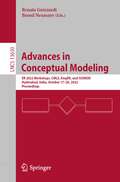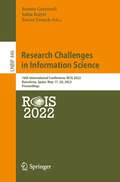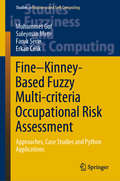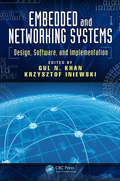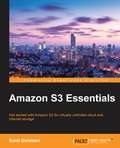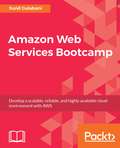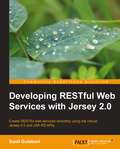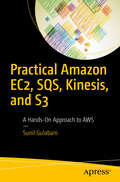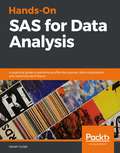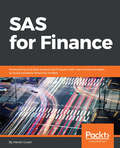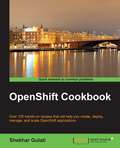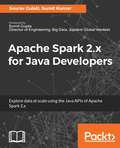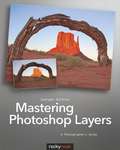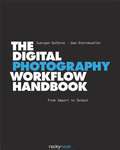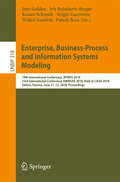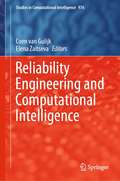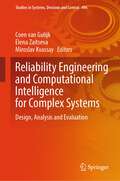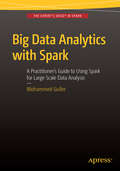- Table View
- List View
Advances in Conceptual Modeling: ER 2022 Workshops, CMLS, EmpER, and JUSMOD, Hyderabad, India, October 17–20, 2022, Proceedings (Lecture Notes in Computer Science #13650)
by Renata Guizzardi Bernd NeumayrThis book constitutes the refereed proceedings of three workshops symposia, held at the 41st International Conference on Conceptual Modeling, ER 2022, as a virtual event, in October 2022. The 11 papers deal with topics such as foundations; business information systems; advanced and cross-disciplinary applications, conceptual modeling, information systems and knowledge graphs; data/object management; engineering; and experience. The following workshops are included in this volume: Third International Workshop on Conceptual Modeling for Life Sciences (CMLS), 5th International Workshop on Empirical Methods in Conceptual Modeling (EmpER); and First International Workshop on Digital Justice, Digital Law and Conceptual Modeling (JUSMOD).
Research Challenges in Information Science: 16th International Conference, RCIS 2022, Barcelona, Spain, May 17–20, 2022, Proceedings (Lecture Notes in Business Information Processing #446)
by Renata Guizzardi Jolita Ralyté Xavier FranchThis book constitutes the proceedings of the 16th International Conference on Research Challenges in Information Sciences, RCIS 2022, which took place in Barcelona, Spain, during May 17–20, 2022. It focused on the special theme "Ethics and Trustworthiness in Information Science". The scope of RCIS is summarized by the thematic areas of information systems and their engineering; user-oriented approaches; data and information management; business process management; domain-specific information systems engineering; data science; information infrastructures, and reflective research and practice. The 35 full papers presented in this volume were carefully reviewed and selected from a total 100 submissions. The 18 Forum papers are based on 11 Forum submissions, from which 5 were selected, and the remaining 13 were transferred from the regular submissions. The 6 Doctoral Consortium papers were selected from 10 submissions to the consortium. The contributions were organized in topical sections named: Data Science and Data Management; Information Search and Analysis; Business Process Management; Business Process Mining; Digital Transformation and Smart Life; Conceptual Modelling and Ontologies; Requirements Engineering; Model-Driven Engineering; Machine Learning Applications. In addition, two-page summaries of the tutorials can be found in the back matter.
Computer Studies class 11 - GSTB
by Gujarat State Board of School TextbooksWritten in simple english language, the Gujarat State Secondary and Higher Secondary Education Board has prepared new syllabi for class 11 based on the open source operating system and compatible open source software tools for various topics of Computer Studies. These syllabi are sanctioned by the Government of Gujarat.
Computer Studies class 9 - GSTB
by Gujarat State Board of School TextbooksThe Gujarat State Secondary and Higher Secondary Education Board has prepared new syllabi based on the open source operating system and compatible open source software tools for various topics of Computer Studies. These syllabi are sanctioned by the Government of Gujarat. It is a matter of pleasure for the Gujarat State Board of School Textbooks to place this textbook of Computer Studies before the students of Standard 9 prepared according to the new syllabus.
Computer Studies Part 1 class 10 - GSTB
by Gujarat State Board of School TextbooksThe Gujarat State Secondary and Higher Secondary Education Board has prepared new syllabi based on the open-source operating system and compatible open-source software tools for various topics of Computer Studies. These syllabi are sanctioned by the Government of Gujarat. The Part 1 of the textbook contains chapters 1 to 7.
Computer Studies Part 2 class 10 - GSTB
by Gujarat State Board of School TextbooksThe Gujarat State Secondary and Higher Secondary Education Board has prepared new syllabi based on the open-source operating system and compatible open-source software tools for various topics of Computer Studies. These syllabi are sanctioned by the Government of Gujarat. The Part 1 of the textbook contains chapters 8 to 16 and appendix 1 to 4.
Computer Adhyan class 10 - GSTB: કમ્પ્યુટર અધ્યયન ધોરણ ૧૦
by Gujrat Rajya Pathyapustak Mandalધોરણ ૧૦ ની કમ્પ્યુટર અધ્યન નું પાઠ્યપુસ્તક છે જેમાં 13 પ્રકરણ આપેલ છે.
Computer Adhyan class 11 - GSTB: કમ્પ્યૂટર અધ્યયન ધોરણ 11
by Gujrat Rajya Pathyapustak Mandalધોરણ ૧૧ ની કમ્પ્યુટર અધ્યન નું પાઠ્યપુસ્તક છે જેમાં 13 પ્રકરણ આપેલ છે.
Robust and Distributed Hypothesis Testing (Lecture Notes in Electrical Engineering #414)
by Gökhan GülThis book generalizes and extends the available theory in robust and decentralized hypothesis testing. In particular, it presents a robust test for modeling errors which is independent from the assumptions that a sufficiently large number of samples is available, and that the distance is the KL-divergence. Here, the distance can be chosen from a much general model, which includes the KL-divergence as a very special case. This is then extended by various means. A minimax robust test that is robust against both outliers as well as modeling errors is presented. Minimax robustness properties of the given tests are also explicitly proven for fixed sample size and sequential probability ratio tests. The theory of robust detection is extended to robust estimation and the theory of robust distributed detection is extended to classes of distributions, which are not necessarily stochastically bounded. It is shown that the quantization functions for the decision rules can also be chosen as non-monotone. Finally, the book describes the derivation of theoretical bounds in minimax decentralized hypothesis testing, which have not yet been known. As a timely report on the state-of-the-art in robust hypothesis testing, this book is mainly intended for postgraduates and researchers in the field of electrical and electronic engineering, statistics and applied probability. Moreover, it may be of interest for students and researchers working in the field of classification, pattern recognition and cognitive radio.
Fine–Kinney-Based Fuzzy Multi-criteria Occupational Risk Assessment: Approaches, Case Studies and Python Applications (Studies in Fuzziness and Soft Computing #398)
by Muhammet Gul Suleyman Mete Faruk Serin Erkan CelikThis book presents a number of approaches to Fine–Kinney–based multi-criteria occupational risk-assessment. For each proposed approach, it provides case studies demonstrating their applicability, as well as Python coding, which will enable readers to implement them into their own risk assessment process. The book begins by giving a review of Fine–Kinney occupational risk-assessment methods and their extension by fuzzy sets. It then progresses in a logical fashion, dedicating a chapter to each approach, including the fuzzy best and worst method, interval-valued Pythagorean fuzzy VIKOR and interval type-2 fuzzy QUALIFLEX. This book will be of interest to professionals and researchers working in the field of occupational risk management, as well as postgraduate and undergraduate students studying applications of fuzzy systems.
Embedded and Networking Systems: Design, Software, and Implementation (Devices, Circuits, and Systems #18)
by GUL N. KHAN AND KRZYSZTOF INIEWSKIEmbedded and Networking Systems: Design, Software, and Implementation explores issues related to the design and synthesis of high-performance embedded computer systems and networks. The emphasis is on the fundamental concepts and analytical techniques that are applicable to a range of embedded and networking applications, rather than on specific embedded architectures, software development, or system-level integration. This system point of view guides designers in dealing with the trade-offs to optimize performance, power, cost, and other system-level non-functional requirements. The book brings together contributions by researchers and experts from around the world, offering a global view of the latest research and development in embedded and networking systems. Chapters highlight the evolution and trends in the field and supply a fundamental and analytical understanding of some underlying technologies. Topics include the co-design of embedded systems, code optimization for a variety of applications, power and performance trade-offs, benchmarks for evaluating embedded systems and their components, and mobile sensor network systems. The book also looks at novel applications such as mobile sensor systems and video networks. A comprehensive review of groundbreaking technology and applications, this book is a timely resource for system designers, researchers, and students interested in the possibilities of embedded and networking systems. It gives readers a better understanding of an emerging technology evolution that is helping drive telecommunications into the next decade.
Amazon S3 Essentials
by Sunil GulabaniGet started with Amazon S3 for virtually unlimited cloud and Internet storageAbout This BookFamiliarize yourself with the concepts of Amazon S3Understand basic operations of bucket, folders, and objects using Amazon S3 SDK JavaLeverage the power of Amazon S3 to effectively store and retrieve dataWho This Book Is ForThis book is intended for System Engineers/ Developers, Software Architects, Project managers, and users who want to explore Amazon S3 SDK Java. If you want to learn about Amazon S3 quickly, then this book is for you. Basic knowledge of Java programming is expected.What You Will LearnStart with the basic concepts of Amazon S3 to get you goingUse Copy Object and Multipart Copy Object for objects of different sizesUnderstand how to use the amazon management console for Amazon S3Learn how to use the AWS SDK of Java and consume the Amazon S3Get to grips with managing the bucket life cycleConfigure CORS to share resources to a different domainDiscover how to develop and deploy the static website on Amazon S3 using different services of AmazonIn DetailAmazon Simple Storage Service (Amazon S3), provides developers and IT teams with secure, durable, and highly-scalable object storage. Amazon S3 is easy to use, with a simple web services interface to store and retrieve any amount of data from anywhere on the web.S3 is automatically web scalable and responds to the requirements of your application and traffic, and therefore offers a key element to help companies deal dynamically with any spike in traffic for their application (such as a free e-book offer).This book starts with the basics of the Amazon S3 and its features, and you will quickly get an understanding how to use the Amazon Management Console for Amazon S3 which is the simplest way to manage Amazon S3. Next, we will cover basic operations on bucket, folder, objects. Once the basic operations are understood, you will know how to use Amazon S3 using Java SDK. Following that, you will learn about Copy Objects and Multipart copy objects for large objects size. You will also learn to manage the life cycle of bucket and how to share resources to the different domain by configuring CORS. The book will then guide you through the development and deployment of a static website on Amazon S3 using different services of Amazon.By the end of the book, you will be able to create a scalable application using Amazon S3.Style and approachThis fast-paced book is a pragmatic guide to writing Amazon S3 applications. Each chapter is blended beautifully with lucid concepts and pertinent examples.
Amazon Web Services Bootcamp: Develop a scalable, reliable, and highly available cloud environment with AWS
by Sunil GulabaniThis fast-paced guide will quickly enhance your skills to develop a highly scalable Cloud environmentKey FeaturesEfficiently build a highly scalable and reliable cloud environment for your applications with AWSLeverage the various AWS components and services to build a secure, reliable, and robust environment to host your applications onThis quick-start guide will quickly enhance your skills to develop highly scalable servicesBook DescriptionAWS is at the forefront of Cloud Computing today. Businesses are adopting AWS Cloud because of its reliability, versatility, and flexible design. The main focus of this book is teaching you how to build and manage highly reliable and scalable applications and services on AWS. It will provide you with all the necessary skills to design, deploy, and manage your applications and services on the AWS cloud platform. We’ll start by exploring Amazon S3, EC2, and so on to get you well-versed with core Amazon services. Moving on, we’ll teach you how to design and deploy highly scalable and optimized workloads. You’ll also discover easy-to-follow, hands-on steps, tips, and recommendations throughout the book and get to know essential security and troubleshooting concepts. By the end of the book, you’ll be able to create a highly secure, fault tolerant, and scalable environment for your applications to run on.What you will learnFind out about IAM to access AWS services securelyExplore EC2 (virtual server) and scale up/down your application based on heavy trafficLearn about unlimited data storage service S3 and host a static website within minutesGet to grips with Relational Databases and NoSQL databases under the AWS ecosystemUnderstand the caching mechanismGet to know about notifications service and monitor AWS servicesSecure and troubleshoot your AWS architectureWho this book is forThis book is for IT professionals and system administrators looking to design, deploy, and manage your applications and services on the AWS cloud platform. It’s also ideal for developers looking to build highly scalable cloud-based services. A basic understanding of AWS would be beneficial.
Developing RESTful Web Services with Jersey 2.0
by Sunil GulabaniThe book will follow a standard tutorial approach and will teach readers how to use the Jersey API for creating RESTful web services.This book is intended for Java EE developers who are building applications on the REST architecture. This is a quick, hands-on guide for learning JAX-RS 2.0. Developers should have some knowledge about RESTful web services but it's not essential to know JAX-RS 1.0.
Practical Amazon EC2, SQS, Kinesis, and S3
by Sunil GulabaniProvide solutions to all your Amazon EC2, SQS, Kinesis, and S3 problems, including implementation using the AWS Management Console, AWS CLI, and AWS SDK (Java). You'll find recipes on implementation and configuration of Amazon EC2, SQS, Kinesis, and S3 along with the code snippets and AWS CLI commands. Practical Amazon EC2, SQS, Kinesis, and S3 uses focused examples that include only the details you need to get things done. You'll see production use cases of Amazon EC2, SQS, Kinesis, and S3 and how to implement cloud watch in projects for these services. Learn how to raise an alarm on Amazon EC2, SQS, Kinesis, and S3 as part of a continuous monitoring system designed to increase performance and avoid side effects in your services. What You'll Learn Manage Amazon EC2, SQS, Kinesis, and S3 using the AWS Management Console Use the AWS CLI Employ the AWS Java SDK Configure alarms on Amazon EC2, SQS, Kinesis, and S3 Who This Book Is For Software developers and architects, system engineers, and project managers
Hands-On SAS for Data Analysis: A practical guide to performing effective queries, data visualization, and reporting techniques
by Harish GulatiLeverage the full potential of SAS to get unique, actionable insights from your data Key Features Build enterprise-class data solutions using SAS and become well-versed in SAS programming Work with different data structures, and run SQL queries to manipulate your data Explore essential concepts and techniques with practical examples to confidently pass the SAS certification exam Book Description SAS is one of the leading enterprise tools in the world today when it comes to data management and analysis. It enables the fast and easy processing of data and helps you gain valuable business insights for effective decision-making. This book will serve as a comprehensive guide that will prepare you for the SAS certification exam. After a quick overview of the SAS architecture and components, the book will take you through the different approaches to importing and reading data from different sources using SAS. You will then cover SAS Base and 4GL, understanding data management and analysis, along with exploring SAS functions for data manipulation and transformation. Next, you'll discover SQL procedures and get up to speed on creating and validating queries. In the concluding chapters, you'll learn all about data visualization, right from creating bar charts and sample geographic maps through to assigning patterns and formats. In addition to this, the book will focus on macro programming and its advanced aspects. By the end of this book, you will be well versed in SAS programming and have the skills you need to easily handle and manage your data-related problems in SAS. What you will learn Explore a variety of SAS modules and packages for efficient data analysis Use SAS 4GL functions to manipulate, merge, sort, and transform data Gain useful insights into advanced PROC SQL options in SAS to interact with data Get to grips with SAS Macro and define your own macros to share data Discover the different graphical libraries to shape and visualize data with Apply the SAS Output Delivery System to prepare detailed reports Who this book is for Budding or experienced data professionals who want to get started with SAS will benefit from this book. Those looking to prepare for the SAS certification exam will also find this book to be a useful resource. Some understanding of basic data management concepts will help you get the most out of this book.
SAS for Finance: Forecasting and data analysis techniques with real-world examples to build powerful financial models
by Harish GulatiLeverage the analytical power of SAS to perform financial analysis efficientlyKey FeaturesLeverage the power of SAS to analyze financial data with easeFind hidden patterns in your data, predict future trends, and optimize risk managementLearn why leading banks and financial institutions rely on SAS for financial analysisBook DescriptionSAS is a groundbreaking tool for advanced predictive and statistical analytics used by top banks and financial corporations to establish insights from their financial data.SAS for Finance offers you the opportunity to leverage the power of SAS analytics in redefining your data. Packed with real-world examples from leading financial institutions, the author discusses statistical models using time series data to resolve business issues.This book shows you how to exploit the capabilities of this high-powered package to create clean, accurate financial models. You can easily assess the pros and cons of models to suit your unique business needs.By the end of this book, you will be able to leverage the true power of SAS to design and develop accurate analytical models to gain deeper insights into your financial data.What you will learnUnderstand time series data and its relevance in the financial industryBuild a time series forecasting model in SAS using advanced modeling theoriesDevelop models in SAS and infer using regression and Markov chainsForecast inflation by building an econometric model in SAS for your financial planningManage customer loyalty by creating a survival model in SAS using various groupingsUnderstand similarity analysis and clustering in SAS using time series dataWho this book is forFinancial data analysts and data scientists who want to use SAS to process and analyze financial data and find hidden patterns and trends from it will find this book useful. Prior exposure to SAS will be helpful but is not mandatory. Some basic understanding of the financial concepts is required.
OpenShift Cookbook
by Shekhar GulatiIf you are a web application developer who wants to use the OpenShift platform to host your next big idea but are looking for guidance on how to achieve this, then this book is the first step you need to take. This is a very accessible cookbook where no previous knowledge of OpenShift is needed.
Apache Spark 2.x for Java Developers
by Sourav Gulati Sumit KumarUnleash the data processing and analytics capability of Apache Spark with the language of choice: Java About This Book • Perform big data processing with Spark—without having to learn Scala! • Use the Spark Java API to implement efficient enterprise-grade applications for data processing and analytics • Go beyond mainstream data processing by adding querying capability, Machine Learning, and graph processing using Spark Who This Book Is For If you are a Java developer interested in learning to use the popular Apache Spark framework, this book is the resource you need to get started. Apache Spark developers who are looking to build enterprise-grade applications in Java will also find this book very useful. What You Will Learn • Process data using different file formats such as XML, JSON, CSV, and plain and delimited text, using the Spark core Library. • Perform analytics on data from various data sources such as Kafka, and Flume using Spark Streaming Library • Learn SQL schema creation and the analysis of structured data using various SQL functions including Windowing functions in the Spark SQL Library • Explore Spark Mlib APIs while implementing Machine Learning techniques to solve real-world problems • Get to know Spark GraphX so you understand various graph-based analytics that can be performed with Spark In Detail Apache Spark is the buzzword in the big data industry right now, especially with the increasing need for real-time streaming and data processing. While Spark is built on Scala, the Spark Java API exposes all the Spark features available in the Scala version for Java developers. This book will show you how you can implement various functionalities of the Apache Spark framework in Java, without stepping out of your comfort zone. The book starts with an introduction to the Apache Spark 2.x ecosystem, followed by explaining how to install and configure Spark, and refreshes the Java concepts that will be useful to you when consuming Apache Spark's APIs. You will explore RDD and its associated common Action and Transformation Java APIs, set up a production-like clustered environment, and work with Spark SQL. Moving on, you will perform near-real-time processing with Spark streaming, Machine Learning analytics with Spark MLlib, and graph processing with GraphX, all using various Java packages. By the end of the book, you will have a solid foundation in implementing components in the Spark framework in Java to build fast, real-time applications. Style and approach This practical guide teaches readers the fundamentals of the Apache Spark framework and how to implement components using the Java language. It is a unique blend of theory and practical examples, and is written in a way that will gradually build your knowledge of Apache Spark.
Mastering Photoshop Layers
by Juergen GulbinsPhotoshop's layers are arguably the most powerful aspect of the software's user interface and are the key to successful image editing in Photoshop. Layers allow for both global and local adjustments to images and can be used to create a number of special effects. Best of all, layers allow for nondestructive editing of your original image. New Photoshop users often see layers as too complicated, and they miss out on the program's full potential. This book will remove the confusion factor by providing an in-depth introduction to layers. Clear, step-by-step instructions and illustrations help the reader quickly master the tools that are relevant for photographers. In this book you will learn about: Working with and building multiple layers Blending layers and which Options to use Using layers to enhance and retouch your images Creating and using layer masks Creating luminosity and saturation layer masks Using Smart Objects and Smart Filters Advanced layer techniques Time-saving shortcuts, tips, and tricks
The Digital Photography Workflow Handbook: From Import to Output
by Juergen Gulbins Uwe Steinmueller<p>The work that follows the capture of a photographic image - the workflow in the digital darkroom - has a significant effect on the quality of the final image. The Digital Photography Workflow Handbook will help you avoid crucial mistakes as you master the craft of photographic post-processing.<br/><br/>\nThis book provides a step-by-step guide through the photographic workflow, from image capture, editing, and asset management, all the way to the perfect photographic print. The workflow presented in this book focuses on RAW images and is based on two of the most popular and powerful software tools: Adobe Photoshop and Lightroom.<br/><br/>\nThe Digital Photography Workflow Handbook can be used as a reference or textbook by both aspiring amateur and professional photographers, as well as by students.</p>
Enterprise, Business-Process and Information Systems Modeling: 19th International Conference, BPMDS 2018, 23rd International Conference, EMMSAD 2018, Held at CAiSE 2018, Tallinn, Estonia, June 11-12, 2018, Proceedings (Lecture Notes in Business Information Processing #318)
by Jens Gulden Iris Reinhartz-Berger Rainer Schmidt Sérgio Guerreiro Wided Guédria Palash BeraThis book constitutes the proceedings of two events held at the CAiSE conference and relating to the areas of enterprise, business process and information systems modeling: The 19th International Conference on Business Process Modeling, Development and Support, BPMDS 2018, and the 23rd International Conference on Evaluation and Modeling Methods for Systems Analysis and Development, EMMSAD 2018. The conferences took place in Tallinn, Estonia, in June 2018. The 13 papers accepted for BPMDS were carefully reviewed and selected from 29 submissions; for EMMSAD 6 papers out of 13 submissions were accepted for publication. For BPMDS 2018, the papers were organized in topical sections as follows: context-awareness in business processes; automatic analysis of business processes; advanced approaches for business process modeling; evaluation of business process modeling techniques; an experience report on modeling collaborative processes. For EMMSAD 2018, the six related papers are listed without further sections.
Reliability Engineering and Computational Intelligence (Studies in Computational Intelligence #976)
by Coen Van Gulijk Elena ZaitsevaComputational intelligence is rapidly becoming an essential part of reliability engineering. This book offers a wide spectrum of viewpoints on the merger of technologies. Leading scientists share their insights and progress on reliability engineering techniques, suitable mathematical methods, and practical applications. Thought-provoking ideas are embedded in a solid scientific basis that contribute to the development the emerging field. This book is for anyone working on the most fundamental paradigm-shift in resilience engineering in decades. Scientists benefit from this book by gaining insight in the latest in the merger of reliability engineering and computational intelligence. Businesses and (IT) suppliers can find inspiration for the future, and reliability engineers can use the book to move closer to the cutting edge of technology.
Reliability Engineering and Computational Intelligence for Complex Systems: Design, Analysis and Evaluation (Studies in Systems, Decision and Control #496)
by Coen Van Gulijk Elena Zaitseva Miroslav KvassayThis book offers insight into the current issues of the merger between reliability engineering and computational intelligence. The intense development of information technology allows for designing more complex systems as well as creating more detailed models of real-world systems which forces traditional reliability engineering approaches based on Boolean algebra, probability theory, and statistics to embrace the world of data science. The works deal with methodological developments as well as applications in the development of safe and reliable systems in various kinds of distribution networks, in the development of highly reliable healthcare systems, in finding weaknesses in systems with the human factor, or in reliability analysis of large information systems and other software solutions. In this book, experts from various fields of reliability engineering and computational intelligence present their view on the risks, the opportunities and the synergy between reliability engineering and computational intelligence that have been developed separately but in recent years have found a way to each other. The topics addressed include the latest advances in computing technology to improve the real lives of millions of people by increasing safety and reliability of various types of real-life systems by increasing the availability of software services, reducing the accident rate of means of transport, developing high reliable patient-specific health care, or generally, save cost and increase efficiency in the work and living environment. Though this book, the reader has access to professionals and researchers in the fields of reliability engineering and computational intelligence that share their experience in merging the two as well as an insight into the latest methods, concerns and application domains.
Big Data Analytics with Spark: A Practitioner's Guide to Using Spark for Large Scale Data Analysis
by Mohammed GullerThis book is a step-by-step guide for learning how to use Spark for different types of big-data analytics projects, including batch, interactive, graph, and stream data analysis as well as machine learning. It covers Spark core and its add-on libraries, including Spark SQL, Spark Streaming, GraphX, MLlib, and Spark ML. Big Data Analytics with Spark shows you how to use Spark and leverage its easy-to-use features to increase your productivity. You learn to perform fast data analysis using its in-memory caching and advanced execution engine, employ in-memory computing capabilities for building high-performance machine learning and low-latency interactive analytics applications, and much more. Moreover, the book shows you how to use Spark as a single integrated platform for a variety of data processing tasks, including ETL pipelines, BI, live data stream processing, graph analytics, and machine learning. The book also includes a chapter on Scala, the hottest functional programming language, and the language that underlies Spark. You'll learn the basics of functional programming in Scala, so that you can write Spark applications in it. What's more, Big Data Analytics with Spark provides an introduction to other big data technologies that are commonly used along with Spark, such as HDFS, Avro, Parquet, Kafka, Cassandra, HBase, Mesos, and so on. It also provides an introduction to machine learning and graph concepts. So the book is self-sufficient; all the technologies that you need to know to use Spark are covered. The only thing that you are expected to have is some programming knowledge in any language. What you'll learn Write Spark applications in Scala for processing and analyzing large-scale data Interactively analyze large-scale data with Spark SQL using just SQL and HiveQL Process high-velocity stream data with Spark Streaming Develop machine learning applications with MLlib and Spark ML Analyze graph-oriented data and implement graph algorithms with GraphX Deploy Spark with the Standalone cluster manger, YARN, or Mesos Monitor Spark applications Who this book is for Big Data Analytics with Spark is for data scientists, business analysts, data architects, and data analysts looking for a better and faster tool for large-scale data analysis. It is also for software engineers and developers building Big Data products. Table of Contents 1. Big Data Technology Landscape 2. Programming in Scala 3. Spark Core 4. Interactive Data Analysis with Spark Shell 5. Writing a Spark Application 6. Spark Streaming 7. Spark SQL 8. Machine Learning with Spark 9. Graph Processing with Spark 10. Cluster Managers 11. Monitoring
